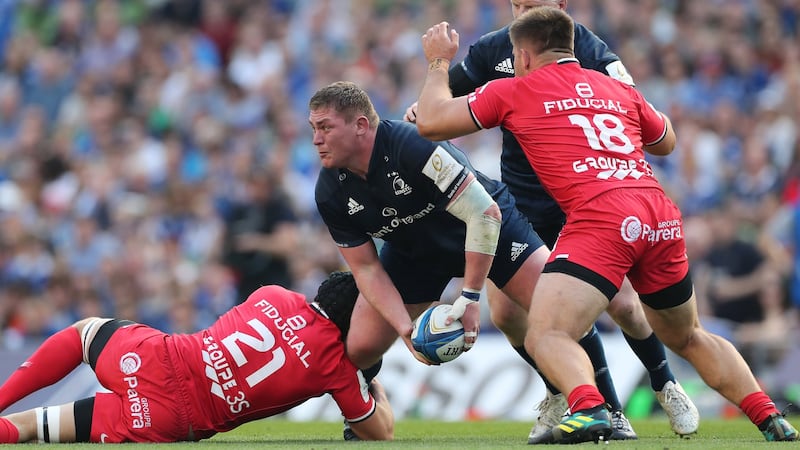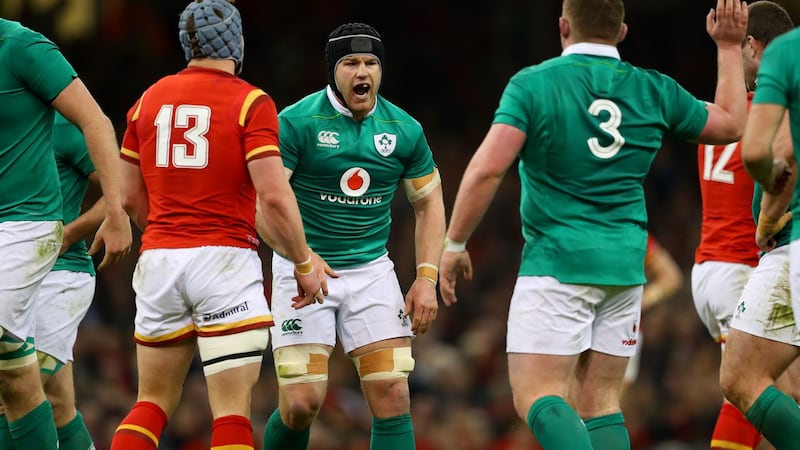Rugby in Ireland used to be all about the club. That’s where you began and where you ended. Professionalism made it about something else.
Serious enough week in the D'Arcy household. All hands on deck. Between battling an outbreak of chickenpox, I got around to reading the Economic and Social Research Institute's (ESRI) report commissioned by the Irish Rugby Football Union, entitled: "Rugby in Ireland: a statistical analysis of participation."
Anyone still reading?
For those who have survived that paragraph I won’t waste your time. I am not questioning the ESRI’s findings but it is hardly revelatory information for volunteers on the ground in places like Wexford Wanderers.
“Children play rugby at clubs and at school, but many drop out when they move from primary to second level and when they leave second level school,” says the report.
We have a good idea why; the pathway becomes harder to follow because the club game has not been adequately cared for in the modern era.
And the IRFU communications department’s response – tagged onto the report’s press release – that the loss of young players at a certain age is being offset by “Play Rugby and XRugby” doesn’t wash with people who truly care about the future of the sport on this island.
It doesn’t address the problem of player fall away when transitioning from primary to secondary school.
A friend of mine, Kevin Cooney, is now involved in Wexford Wanderers because his son has taken up the game. Mini Rugby in clubs is well organised but pales in comparison to the GAA. Parents know this because they bring their children to both.
There are still 200 kids out every Saturday morning in Wexford. I’m due down for a book signing. I wrote Gordon’s Game with Paul Howard, a story aimed at 10- to 12-year-olds, because I remember being that boy.
It is 1991. Another Gordon [Hamilton] has just scored a sensational try at Lansdowne road in a World Cup quarter-final. The blonde mop of Simon Geoghegan gives me a new hero as hurley and sliotar get set aside to find out what running with the oval ball is all about.
Kids from places like New Ross or Ballina are just as desperate to play for Leinster or Connacht as boys in private schools. Tadhg Furlong and Seánie O’Brien will back me up.
There is a moral obligation to give these children a clear route into the professional game that does not leave them feeling helpless when the big noise from Clongowes or St Michael’s arrives at trials.
Walk away
Is this being done?
Not well enough.
The route to the top for kids from non-rugby patches remains fraught with resistance every step of the way. I understand why they walk away. I get why the lack of barriers in GAA or soccer can be more appealing.
I am saying nothing new. If change is ever going to happen it will take time. And serious investment.

Real and sustainable change will probably only occur in Irish rugby when the first generation of professional players begin to infiltrate the IRFU committee structure. We are in our forties now, so it will take another 10 to 15 years before my peers rise to positions of influence.
The man currently responsible for enacting change is the IRFU high performance director David Nucifora.
The former Wallaby hooker has signed his second contract – the first was for five years – to run Irish rugby. It is not just the professional game he oversees. Nucifora has engaged with women’s rugby and the amateur clubs. Granted, these interactions have not been as fruitful as other ventures, including his gift to Irish rugby – a never before seen Sevens programme intent on winning Olympic medals.
Nucifora has inevitably taken some criticism – change is hard and he has proved himself a tough negotiator – but the 57-year-old Australian has done an impressive job, from recruiting a coach such as Andy Friend to bringing Johnny Sexton home and keeping others from leaving.
It’s been an impressive five years for the professional game (let’s ignore the elephant for now). So, viewing from the top down, all is well.
The ESRI report reopens an old wound; when kids move from the club into the schools game there is a huge drop off in numbers.
You still can’t play for both in Leinster if a student is attending one of the top schools. So, if a talented teenager is on the Blackrock Junior Cup team he cannot double up on the Blackrock Rugby Club team.
The report states that rugby is more inclusive in Munster than Leinster, as a whole: “Participation in Munster, both active and social, is less confined to higher socio-economic groups and, probably as a consequence, is higher overall.”
This has always been the case because the sport has a greater spread in the southern province, especially in Limerick city and surrounding clubs where it has long been the people’s sport with hurling rooted in parishes around the county. (Granted, 2016 All-Ireland club winners Na Piarsaigh are a city club).
Best chance
The report states that there is a higher participation rate in Leinster when compared to Munster, once a household income threshold is passed. And it remains the case that attending private schools in south county Dublin, Newbridge, Belvedere College and Clongowes Wood gives teenagers the best chance of playing professional rugby.
Not sure we needed a report to tell us how the game has evolved in Munster and Leinster. Maybe it is telling us that nothing has really changed despite a glorious two decades.
If the biggest challenge facing Irish rugby is the drop offs in numbers by teenagers and young adults, I’d love to see how the IRFU are tackling that.
One way would be by allowing a person to stay connected to their club from mini-rugby all the way up to adult teams. The report also focuses on supporter and volunteer participation, as sport is not just about what happens on the field. Maintaining a sense of community is vital for each club’s continued existence. How can this be maintained if key stakeholders are absent for their formative years, and do they come back through duty or obligation?

Is that why Ulster and Munster academies have been unable to enhance their first-team squads every season with one or two players capable of going on to play international rugby?
The lack of focus on clubs, I believe, is a root cause for Munster’s inability to produce a flood of home-grown talent. The panacea for Munster will never apply to Leinster and vice versa.
Munster Rugby was built upon the clubs. Ronan O’Gara kicking goals for Cork Con was how most people first heard about him. The all-conquering Shannon of the late 1990s filled up a Munster pack that stood up to the French and English clubs.
The Shannons, Cork Cons, Garryowens and Young Munsters uniting under one banner is what makes them such a force of nature in Thomond Park.
They must rediscover this pathway. Or they can keep recruiting South Africans and maintain short-term growth that way. It will probably deliver a Pro14 title. With Joey Carbery at 10 and RG Snyman up front they could win a third European title in two or three years’ time.
Maybe by then the academy will be producing modern versions of the hardy souls I encountered. Munster was built on the clubs because that’s where men like Donncha O’Callaghan, Denis Leamy, Mick Galwey and John Hayes came from. You could rewrite those names by place as Cork, Tipperary, Kerry and Limerick.
Fall off in participation rates at club level has mutated the Munster DNA.
It is worth highlighting what socio-economic groups play rugby in each province. There are efforts from Leinster HQ in UCD to spread their tentacles into lower income areas.
Old conversation
This is an old conversation. After the 2015 World Cup I wrote:
“A different way of facing this problem is for the IRFU to make Joe Schmidt’s next role to assess and analyse Irish rugby from the ground up. He has already delivered two Six Nations titles and got us to a World Cup quarter-final, which leaves him ideally placed to put in place structures where the next wave of players are better coached from a younger age. It would mean overhauling how we mould rugby players in Ireland from the bottom up.
“All we need are better passers, better kickers and better decision-makers. We know how to turn them into athletes, but there are too many 18- and 19-year-olds learning passing techniques they need to have in their locker by 14 or 15.
“They may say I’m a dreamer, but it would be the best money the IRFU ever spent. It would be about raising the standards of coaching in every club in Ireland by lowering the age that teenagers are exposed to genuine coaching expertise.
“I do mean every club. Tullow has given us Seán O’Brien while Tadhg Furlong is from New Ross. Maybe Enniscorthy can provide the next professional flanker or prop. It’s about ensuring the talent that will come through is more comfortable with the ball and tactically smarter without it.
“See a 12-year-old from any hurling county hitting a sliotar. It starts as soon as he can wield a hurley.”
Here we are again. What sort of column will be penned in 2023? And will there be an instant cure for chickenpox by then?
There are over 200 rugby clubs on the island. Until we see a clear path for children in a club, in conjunction with schools, before using the All-Ireland League as a genuinely alternative route into the professional ranks, then real progress cannot happen.
This demands an enormous investment in coaching. I’m guessing up to €50 million over 10 years.
Leinster continue to produce players from the private schools such as Ronán Kelleher and Max Deegan, who both looked very comfortable in Lyon last weekend, but this is not happening in the other three provinces.
Nucifora has bolstered the other squads with a top down solution of sending Leinster players to Limerick, Belfast and Galway. The tactic is simple; if you want to play for Ireland you need to be a starter elsewhere. It has worked. It has improved the system on a short to medium term basis. It has been a long overdue spreading of the wealth.
But is that how it is going to be forever more?
If we had adopted a club-focused strategy, with investment in coaching, back in 2014 we’d have an extra layer of highly skilled 18-year-olds entering the professional ranks right now.
But Nucifora’s brief comes from the IRFU committee. He has done a very good job but his remit does not appear to include a long-term plan.
An outsider is what was needed. His appointment is sound but the clubs are still focused on looking after their own patch. Collective investment in coaching would see every ship rise on the same tide.
What is the plan to reduce the drop in players at either end of their teenage years?
The clubs hold the key. They always have.












